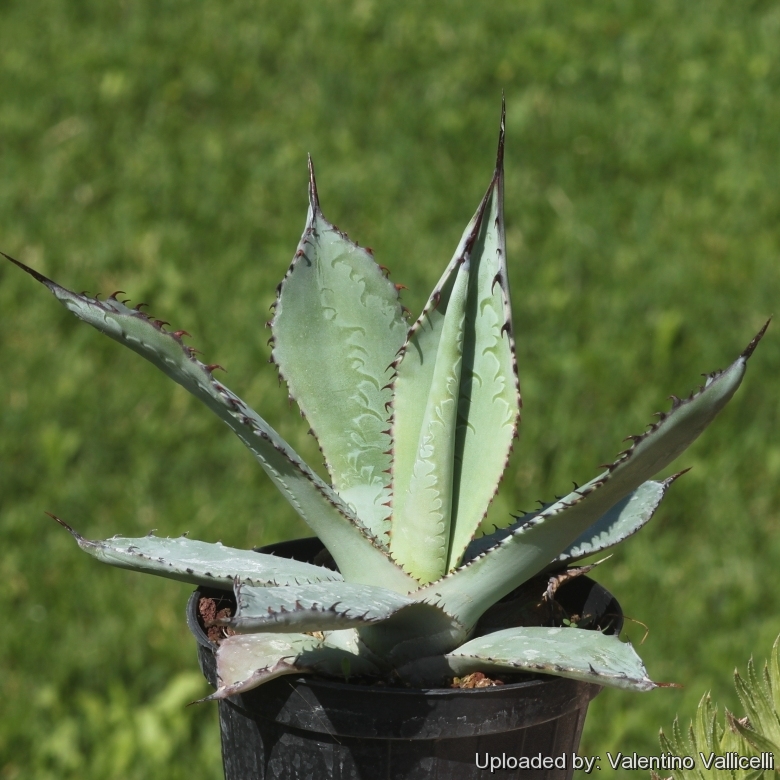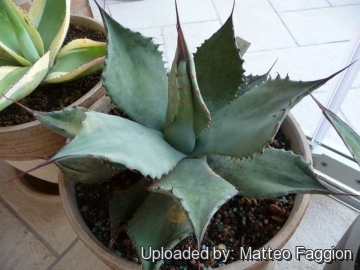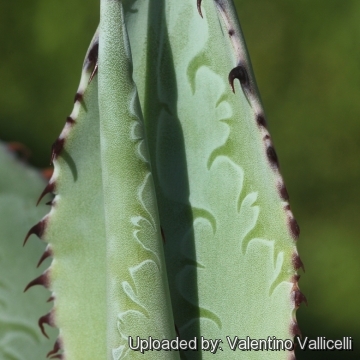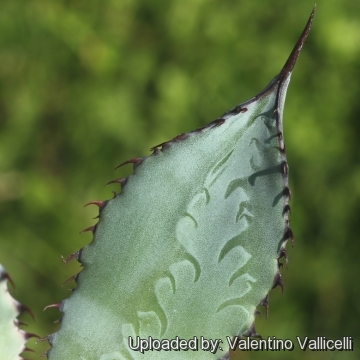
Agave flexispina Photo by: Valentino Vallicelli
The leaf surfaces are decorated by impressions made by the margins of other leaves as they emerge from the center.
Origin and Habitat: Mexico (Northern America), Chihuahua (Matamoros, Parral, Santa eulalia) Durango (Canutillo, La Zarca, Santiago papasquiaro ), Zacatecas (Sierra papanton, Sombrerete)
Type locality: Tepehuanes, the type locality.
Altitude: 1300-2100 metres above sea level.
Habitat: It grows in oak woodland and grama grassland often on open volcanic rocky slopes.
Synonyms:
Common Names include:
ENGLISH: Flexible-spined Hardy Century Plant
Description: Agave flexispina is an attractive, symmetrical, small-sized agave, single but will offset occasionally once established. It is a rarely grown agave, related to Agave palmeriSN|22538]]SN|22538]] and Agave shrevei.
Rosette: Open, small, depressed subglobose, about 25-35 cm tall, 50-70 cm in diameter with about 30 leaves when mature.
Leaves: 6-8 cm wide and 12-30 cm long, yellowish-green to powder blue almost white, smooth, regularly spreading, deeply concave. Margin undulating, with dark reddish or brown flexible spines. Apical spines flexuous 5 mm wide and 25-35 mm long very openly grooved dark-red turning grey.
Inflorescence: Paniculate, narrow, straight or curved 2,5-4 m tall. The flowers are borne in loose, irregular branches on the top part of the inflorescence.
Flowers: 50-70 mm long, green to yellow. Perianth tube 13-18 nm long, cylindrical to cup-shaped.
Blooming season: Summer.
Fruits: Three-chambered capsule, 35-45 mm long and 15-17 mm brown, wide variably-shaped.
Seeds: Moon-shaped, black, 5,5-7 mm long and 4-5 mm wide.
Bibliography: Major references and further lectures
1) Howard Scott Gentry “Agaves of Continental North America” University of Arizona Press, 01/Feb/2004
2) Urs Eggli “Illustrated Handbook of Succulent Plants: Monocotyledons” Springer, 2001
3) Hermann Jacobsen ”A Handbook of Succulent Plants: Abromeitiella to Euphorbia” Blandford Press, 1960
4) Paul Carpenter Standley “Trees and Shrubs of Mexico: Fagaceae-Fabaceae” U.S. Government Printing Office, 1926
5) August J. Breitung “The Agaves” Abbey Garden Press
 Agave flexispina Photo by: Matteo Faggion
Agave flexispina Photo by: Matteo Faggion Undulations on the leaf or "bud printing" occurs when leaves imprint on each other due to pressure in the conical bud. Photo by: Valentino Vallicelli
Undulations on the leaf or "bud printing" occurs when leaves imprint on each other due to pressure in the conical bud. Photo by: Valentino Vallicelli Agave flexispina Photo by: Valentino Vallicelli
Agave flexispina Photo by: Valentino Vallicelli Agave flexispina Photo by: Valentino Vallicelli
Agave flexispina Photo by: Valentino Vallicelli Agave flexispina Photo by: Cactus Art
Agave flexispina Photo by: Cactus ArtSend a photo of this plant.The gallery now contains thousands of pictures, however it is possible to do even more. We are, of course, seeking photos of species not yet shown in the gallery but not only that, we are also looking for better pictures than those already present.
Read More... Cultivation and Propagation: Agave flexispinaSN|502]]SN|502]] is one of the most easy-to-grow species though relatively slow growing.
Growing rate: Agave flexispinaSN|502]]SN|502]] is a very slow-growing species; even in cultivation with generous irrigation it takes at least 20 years to flower.
Soil: It needs a very well-drained, soil.
Repotting: Use pot with good drainage.
Watering: Water regularly during the growing season from spring to autumn. In winter watering this plant can be done once every 1-2 months, there is no need to mist the leaves. Plants cultivated outdoors are drought tolerant and takes blasting heat and full sun.
Exposure: It do well in full sun or a lightly shaded area.
Feeding: During the beautiful season it’s good to enrich the soil using a fertilizer rich in potassium and phosphorous, but poor in nitrogen, because this chemical element doesn’t help the development of succulent plants, making them too soft and full of water.
Hardiness: Acclimated seddlings can tolerate temperatures as low as -7° C and mature plants will withstand temperatures as low as – 15° C or even less, particularly when dry but in cultivation it is best to avoid severe freezing temperatures.
Heat Tolerance: Excellent.
Uses: Because of their symmetrical form these plants are very attractive when grown in pots, containers, rockeries and embankments. They are quite versatile. Plants can be grouped together or planted among boulders in a rock or cactus garden.
Traditional uses: Agave flexispinaSN|502]]SN|502]] is one of the more edible agaves used extensively by the desert dwelling Indians. Young flower stalks, buds, and hearts of plants were roasted and eaten. Food thus obtained often became a dietary staple, even into drought years. Alcoholic drinks were also manufactured from the sweet juices of this and other agaves. The fibres of this plant was also used to make cloth, bowstrings, and ropes.
Propagation: Relatively easy to propagate by seeds or by suckers (if available). Sow at any time of year in a well-aerated compost at a temperatures of 22-24°C . Stand the pots in water, moisten thoroughly and drain. Scatter and press lightly the seed onto the top of the compost. But do not cover the small seeds with compost. Secure a polythene bag around the pot or cover the container with glass or and place in a warm shaded place. If possible, germinate in a propagator. Some seedlings may appear within a week or 10 days others will take longer. At lower temperatures, germination usually takes considerably longer. Once germination has taken place, remove gradually the glass or plastic and move into a good light but not in direct sun. If the young plants are exposed to too much sun, or the compost dries out, they may stop growing and often turn red; once they stop, it is often difficult to persuade them to start growing again. Never let the pots dry out-but don't saturate them either. A sodden compost is as harmful as a dry one.
Remove the basal suckers in spring or summer and let the cuttings dry for a few days before inserting in compost.
















